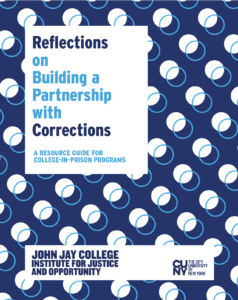Reflections on Building a Partnership with Corrections: A Resource Guide for College-in-Prison Programs
 New York has been a leader in education in prison since the 1800s. At its peak in the 1990s, when incarcerated people were eligible for federal Pell and New York State Tuition Assistance Program (TAP) grants, New York had 70 higher education programs operating in state prisons. In the mid-1990s, when legislators revoked Pell and TAP for incarcerated people, the number of students dropped from 3,445 to 256. In December 2020, after a 26-year ban, congress reinstated access to federal Pell grants for incarcerated students. Now, with 67 new programs receiving Second Chance Pell status, we are disseminating this publication to help providers cultivate and improve relationships with their corrections partners.
New York has been a leader in education in prison since the 1800s. At its peak in the 1990s, when incarcerated people were eligible for federal Pell and New York State Tuition Assistance Program (TAP) grants, New York had 70 higher education programs operating in state prisons. In the mid-1990s, when legislators revoked Pell and TAP for incarcerated people, the number of students dropped from 3,445 to 256. In December 2020, after a 26-year ban, congress reinstated access to federal Pell grants for incarcerated students. Now, with 67 new programs receiving Second Chance Pell status, we are disseminating this publication to help providers cultivate and improve relationships with their corrections partners.
This guide is part of an effort to provide college providers with the necessary tools for developing programs that are responsive to the unique environment of correctional facilities. While designed specifically for college programs that operate in New York State Department of Corrections and Community Supervision (DOCCS) facilities, this guide may also be useful for organizations and colleges outside of New York that wish to establish or enhance college-in-prison programs.
Reflections on Building a Partnership with Corrections: A Resource Guide for College-in-Prison Programs grew out of our work operating the Prison-to-College Pipeline, our college-in-prison program at Otisville Correctional Facility, and our Technical Assistance work to seven college-in-prison providers throughout New York State. It includes information on the history of college-in-prison programs in New York state, foundations for productive partnerships, the structure and legal authority of DOCCS, policies and procedures relevant to college-in-prison programs, job descriptions of key facility staff, and insights informed by our collective experiences working with DOCCS.
